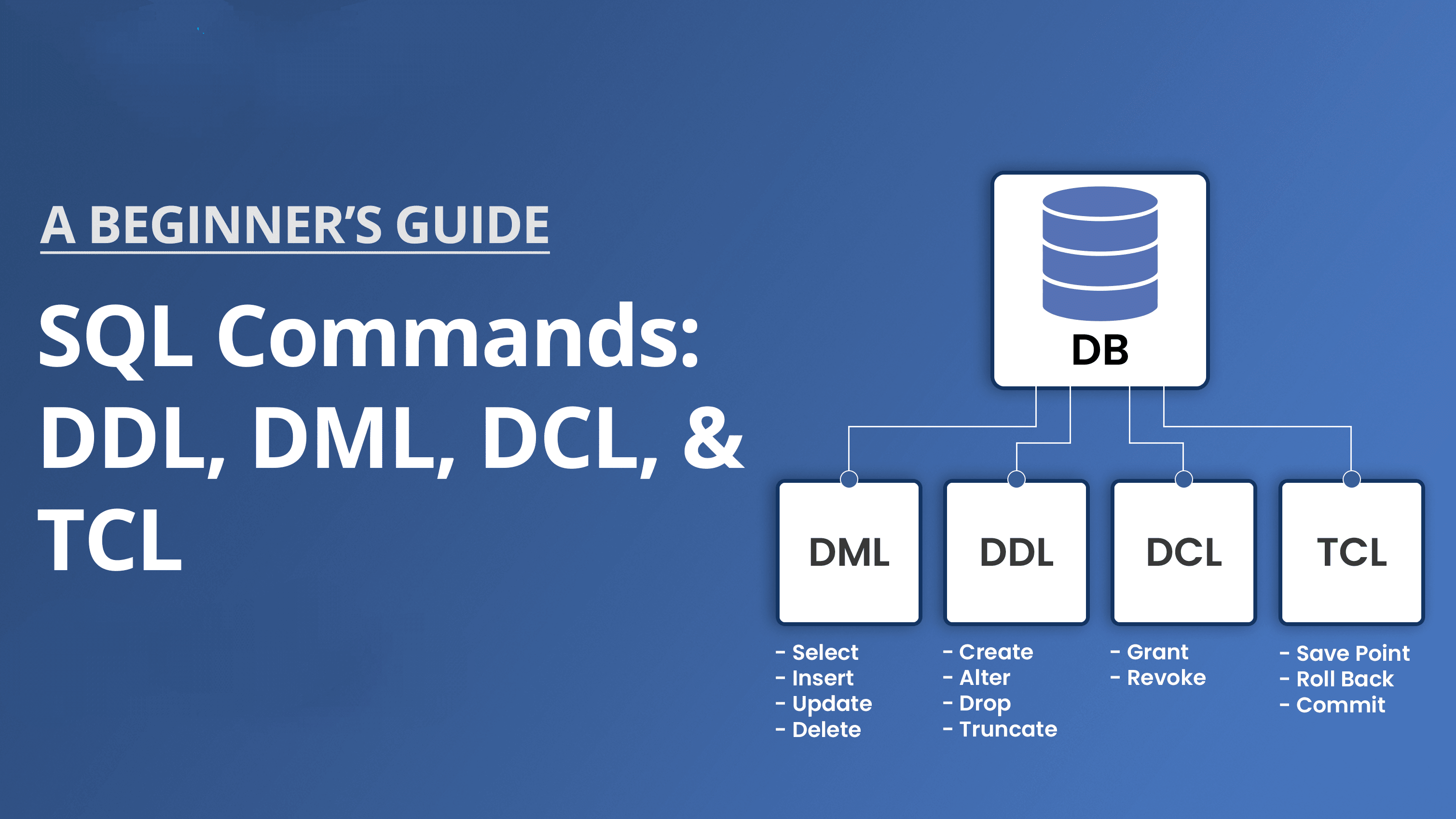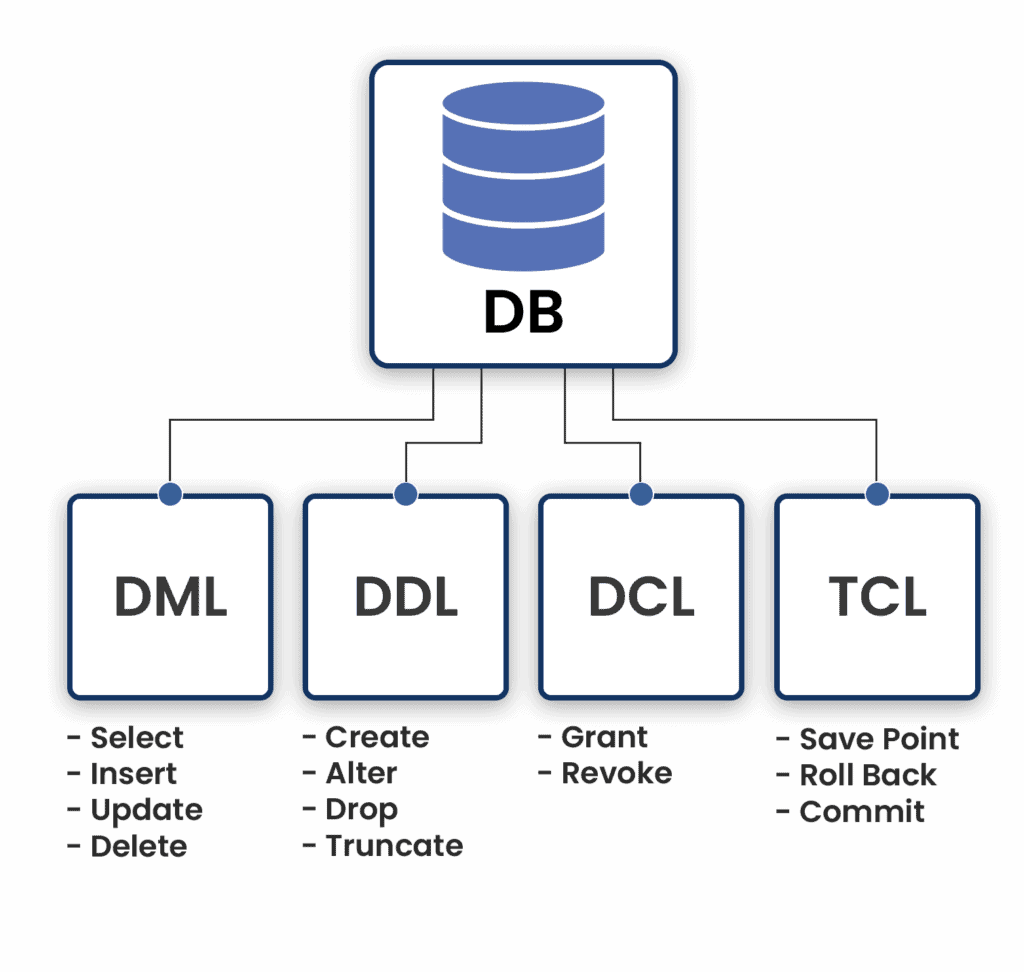Understanding SQL Commands: Types and Examples
 Aditya Gadhave
Aditya Gadhave
What is SQL Commands ?
SQL commands are instructions. It is used to communicate with the database. It is also used to perform specific tasks, functions, and queries of data.
SQL can perform various tasks like create a table, add data to tables, drop the table, modify the table, set permission for users.
These SQL commands are primarily divided into four groups:
Data Definition Language (DDL)
Data Manipulation Language (DML)
Data Control Language (DCL)
Transaction Control Language (TCL)

1. Data Definition Language (DDL)
DDL changes the structure of the table like creating a table, deleting a table, altering a table, etc.
All the command of DDL are auto-committed that means it permanently save all the changes in the database.
Here are some commands that come under DDL:
CREATE
ALTER
DROP
TRUNCATE
a. CREATE :
It is used to create a new table in the database.
Syntax:
- CREATE TABLE TABLE_NAME (COLUMN_NAME DATATYPES[,....]);
Example:
- CREATE TABLE EMPLOYEE(Name VARCHAR2(20), Email VARCHAR2(100), DOB DATE);
b. DROP:
It is used to delete both the structure and record stored in the table.
Syntax
- DROP TABLE table_name;
Example
- DROP TABLE EMPLOYEE;
c. ALTER:
It is used to alter the structure of the database.
This change could be either to modify the characteristics of an existing attribute or probably to add a new attribute.
Syntax:
To add a new column in the table
- ALTER TABLE table_name ADD column_name COLUMN-definition;
To modify existing column in the table:
- ALTER TABLE table_name MODIFY(column_definitions....);
EXAMPLE :
ALTER TABLE STU_DETAILS ADD(ADDRESS VARCHAR2(20));
ALTER TABLE STU_DETAILS MODIFY (NAME VARCHAR2(20));
d. TRUNCATE:
It is used to delete all the rows from the table and free the space containing the table.
Syntax:
- TRUNCATE TABLE table_name;
Example:
- TRUNCATE TABLE EMPLOYEE;
2. Data Manipulation Language
DML commands are used to modify the database. It is responsible for all form of changes in the database.
The command of DML is not auto-committed that means it can't permanently save all the changes in the database. They can be rollback.
Here are some commands that come under DML:
INSERT
UPDATE
DELETE
a. INSERT:
The INSERT statement is a SQL query. It is used to insert data into the row of a table.
Syntax:
INSERT INTO TABLE_NAME
(col1, col2, col3,.... col N)
VALUES (value1, value2, value3, .... valueN);
Or
INSERT INTO TABLE_NAME
VALUES (value1, value2, value3, .... valueN);
For example:
- INSERT INTO javatpoint (Author, Subject) VALUES ("Sonoo", "DBMS");
b. UPDATE:
This command is used to update or modify the value of a column in the table.
Syntax:
- UPDATE table_name SET [column_name1= value1,...column_nameN = valueN] [WHERE CONDITION]
For example:
UPDATE students
SET User_Name = 'Sonoo'
WHERE Student_Id = '3'
c. DELETE:
It is used to remove one or more row from a table.
Syntax:
- DELETE FROM table_name [WHERE condition];
For example:
DELETE FROM javatpoint
WHERE Author="Sonoo";
3. Data Control Language
DCL commands are used to grant and take back authority from any database user.
Here are some commands that come under DCL:
Grant
Revoke
a. Grant:
It is used to give user access privileges to a database.
Example
- GRANT SELECT, UPDATE ON MY_TABLE TO SOME_USER, ANOTHER_USER;
b. Revoke:
It is used to take back permissions from the user.
Example
- REVOKE SELECT, UPDATE ON MY_TABLE FROM USER1, USER2;
4. Transaction Control Language
TCL commands can only use with DML commands like INSERT, DELETE and UPDATE only.
These operations are automatically committed in the database that's why they cannot be used while creating tables or dropping them.
Here are some commands that come under TCL:
COMMIT
ROLLBACK
SAVEPOINT
a. Commit:
Commit command is used to save all the transactions to the database.
Syntax:
- COMMIT;
Example:
DELETE FROM CUSTOMERS
WHERE AGE = 25;
COMMIT;
b. Rollback:
Rollback command is used to undo transactions that have not already been saved to the database.
Syntax:
- ROLLBACK;
Example:
DELETE FROM CUSTOMERS
WHERE AGE = 25;
ROLLBACK;
c. SAVEPOINT:
It is used to roll the transaction back to a certain point without rolling back the entire transaction.
Syntax:
- SAVEPOINT SAVEPOINT_NAME;
5. Data Query Language
DQL is used to fetch the data from the database.
It uses only one command:
- SELECT
a. SELECT:
This is the same as the projection operation of relational algebra.
It is used to select the attribute based on the condition described by WHERE clause.
Syntax:
SELECT expressions
FROM TABLES
WHERE conditions;
Example:
SELECT emp_name
FROM employee
WHERE age > 20;
Subscribe to my newsletter
Read articles from Aditya Gadhave directly inside your inbox. Subscribe to the newsletter, and don't miss out.
Written by

Aditya Gadhave
Aditya Gadhave
👋 Hello! I'm Aditya Gadhave, an enthusiastic Computer Engineering Undergraduate Student. My passion for technology has led me on an exciting journey where I'm honing my skills and making meaningful contributions.